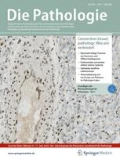Zusammenfassung
Adenokarzinome der intra- und extrahepatischen Gallenwege sind sehr seltene Tumoren und entstehen durch maligne Transformation des Epithels der extrahepatischen Gallengänge sowie der großen und mittleren intrahepatischen Gangabschnitte. Dabei nehmen die intrahepatischen Cholangiokarzinome ihren Ausgang in den kleinen, portalen, intralobulären Gallengängen, die proximal des rechten und linken Ductus hepaticus gelegen sind. Extrahepatische Gallengangskarzinome entstehen im Ductus hepaticus dexter, sinister oder communis, Ductus cysticus oder Ductus choledochus. Ist ihr primärer Ursprungsort die Bifurkation, werden sie Klatskin-Tumoren genannt. Für die intrahepatischen Cholangiokarzinome gilt die UICC-TNM-Klassifikation der primären Lebertumoren, Karzinome der extrahepatischen Gallenwege besitzen eine eigene UICC-TNM-Klassifikation. Ätiopathogenetisch sind Faktoren, die mit einer chronischen Entzündungsreaktion einhergehen, relevant. So sind parasitäre Erkrankungen (Schistosomiasis), Colitis ulcerosa mit konsekutiver primär sklerosierender Cholangitis oder konnatale Leberzysten im Sinne von Duktalplattenanlagestörungen mit einer erhöhten Inzidenz von Gallengangskarzinomen assoziiert. Histologisch handelt es sich bei den Gallengangskarzinomen um Adenokarzinome, was die differenzialdiagnostische Abgrenzung zu Metastasen erschwert. Generell gilt, dass die hochgradige Dysplasie dem Carcinoma in situ gleichgesetzt wird wie auch im übrigen Gastrointestinaltrakt. Dabei hat sich eine 2-stufige Klassifikation der Dysplasie (hoch- und niedriggradig) als reproduzierbarer erwiesen als eine dreistufige.
Abstract
Adenocarcinomas of the intra- and extrahepatic bile ducts are rare tumors that begin with malignant transformation of the bile duct epithelia. Intrahepatic cholangiocarcinomas derive from the small bile ducts located proximally to the right and left hepatic ducts. Extrahepatic bile duct carcinomas originate in the right or left hepatic duct, the cystic duct, or the choledochal duct. Tumors located at the bifurcation are called Klatskin tumors. The intrahepatic cholangiocarcinomas are classified according to the TNM classification of liver tumors, while the extrahepatic bile duct tumors have their own TNM classification. Several factors, accompanied by a chronic inflammatory reaction, have been discussed in the etiopathogenesis of these tumors: schistosomiasis, ulcerative colitis with primary sclerosing cholangitis, and inborn bile duct cysts of the liver as a consequence of a disturbance of the ductal plate formation. Over 95% of bile duct tumors are adenocarcinomas. In the nomenclature of precursor lesions a two-grade classification of dysplasia (low-grade versus high-grade) has been found to be more reproducible.
Author information
Authors and Affiliations
Rights and permissions
About this article
Cite this article
Tannapfel, A., Wittekind, C. Anatomie und Pathologie des intrahepatischen und extrahepatischen Gallengangskarzinoms. Pathologe 22, 114–123 (2001). https://doi.org/10.1007/s002920000416
Issue Date:
DOI: https://doi.org/10.1007/s002920000416

